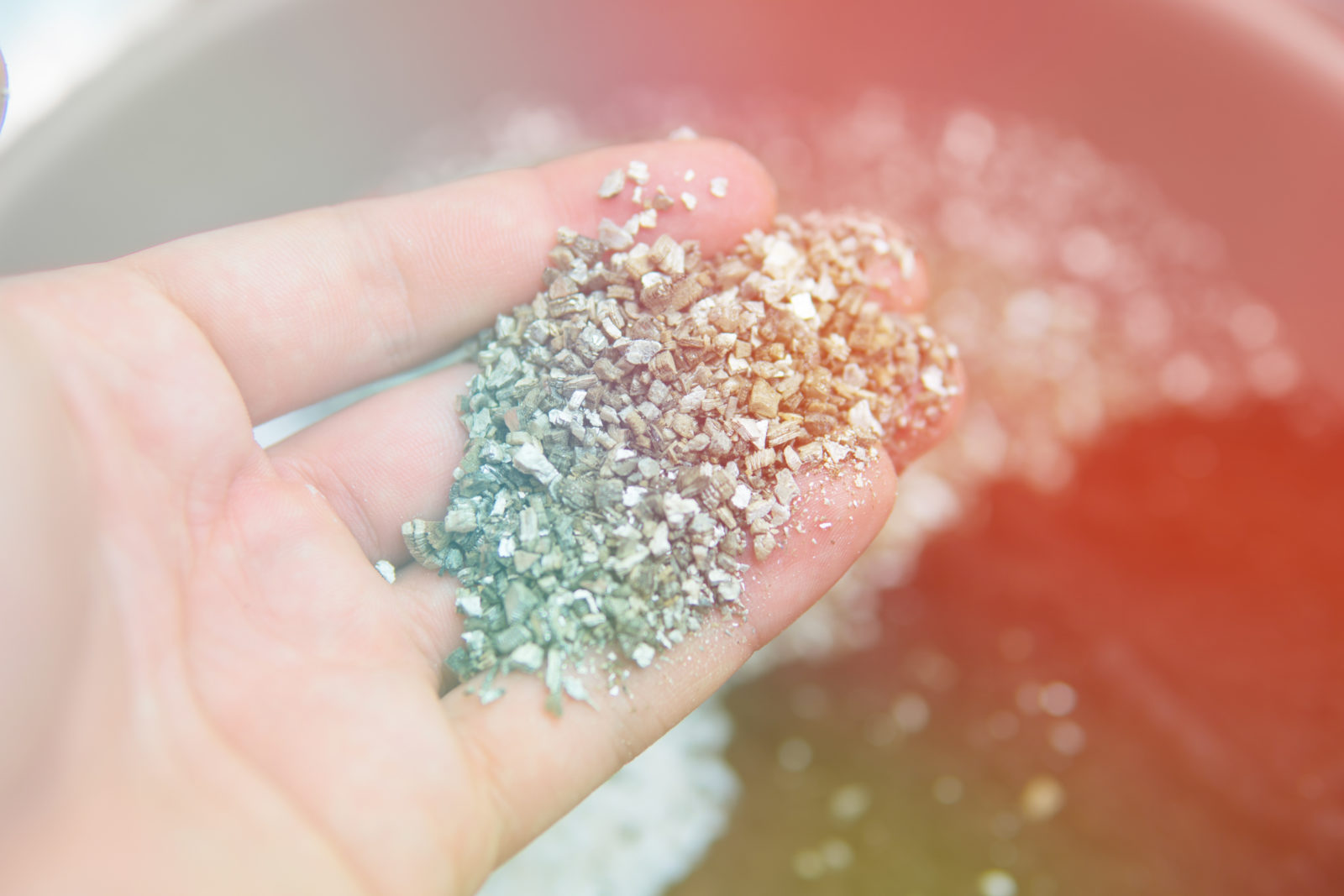Perlite and Vermiculite – Uses and Benefits in the Agricultural Industry
Perlite and vermiculite are two very different natural minerals that nevertheless offer very similar functions and benefits to the agricultural industries. What follows is a thorough explanation and discussion of these substances and their uses.
What is perlite?
Perlite is a silica mineral, formed in cooling magma through the hydration of obsidian. It presents as coarse, grey – white granules which have the unusual property of expanding when heated. It is this expanded form that is used commercially. From a chemical perspective, it consists predominantly of silicon dioxide (+/-70-75%), as well as aluminium oxide (12-15%), with traces of various metal oxides. It also contains approximately 4 % of crystal water that during the softening phase expands the granules as the water vapour is formed.
Because of its low density and affordability, it has been put to a number of commercial uses, most notably in the construction, filtration and agricultural industries. It is the latter capacity that interests us in this article, although Sun Silicates supplies perlite to the construction and filtration industry too. In agriculture and more specifically in hydroponics it is a very popular soil amendment and substrate or growing media, i.e. an additive mixed with soil or other substrates such as peat moss, coir and bark to improve its cultivation properties.
The Role of Perlite in Hydroponic Culture
Many hydroponic growers make use of perlite – regardless of what their specific crop may be. The main uses of the product in this area derive from its lightweight, porous granule structure. When added to substrates , it prevents clumping, improves aeration and drainage, improving the growing media to ensure fast growing roots systems that in turn ensure healthy plants. Perlite’s relationship with water is key to its usefulness. On the one hand, it helps to retain water, ensuring that plants always have all the moisture they need. On the other, it also provides excellent drainage so that there is never too much water around the plant’s roots.
Perlite brings the following benefits as a soil amendment and hydroponic growing medium:
- Reusable: There is never any need to throw perlite away. After you have finished growing one crop, you simply plant another. The granules can even be cleaned and sterilized before you plant again.
- Eliminates anaerobic zones: Plants need air. Some growing mediums can form clumps, making it difficult for air to move through the soil and around the plant’s roots. This can be disastrous for the plants. Perlite is extremely efficient at retaining air and allowing movement of oxygen as a result of its coarse, clump-resistant texture.
- Highly economical: Perlite is a very inexpensive mineral. Particularly if you are planting on a large scale, you will find perlite extremely economical. You get a lot for what you pay, and you typically only use a small amount per application.
- Sterile and pH neutral
Perlite is unique among most popular growing media in that it is entirely inorganic and inherently sterile. Many other media need to be sterilised before use. This is not the case with perlite – although you can clean and sterilize it before re use as an extra precaution.. It is also pH neutral, which is crucial for some crops, which can tend to be very sensitive to the acidity or alkalinity of the growing medium.
These benefits are extremely useful when perlite is used as a soil amendment, but particularly when the mineral is employed in a hydroponic set-up, as a soilless growing medium.
How to use perlite as a growing medium
Perlite as an agricultural aid was first developed by a group of Scottish horticulturalists, and has been shown to be one of the most easily managed hydroponic growing media, increasing plant yield and having the fastest growth rate of any of the media employed by hydroponic growers. It is highly versatile and can be used either as a single medium or in combination with others and is suitable for systems such as Dutch bucket and Bato bucket setups, or in a variety of other ways.
In the Dutch or Bato bucket system, a series of buckets filled with perlite can be arranged along an irrigation line, where a nutrient solution is pumped along the line and administered to each bucket, using a drip emitter. The solution that is not absorbed by the plants is then drained from the buckets and returned to the reservoir. The excellent drainage of the perlite means that it facilitates this cycle very well.
With perlite, you can also plant from cuttings very successfully. When cuttings are placed in a new growing medium, they need to seek out nutrient and water-rich areas as quickly as possible. Perlite easily allows the movement of roots and provides many of these nutrient rich pockets for cuttings to draw from. Cuttings take root and grow strong very quickly in perlite.
With perlite being so light and low in density, it doesn’t work too well on its own if you are working with deep water culture or ebb-and-flow hydroponic systems. This is because perlite tends to float when water levels get high. In these cases, however, it can easily be combined with a larger, heavier and denser medium, such as vermiculite or coco coir. In these combinations, the perlite won’t float or get washed away and will still provide you with all its benefits
Common soil problems and how to solve them
There are basically four main problems that growers experience with soil and these can usually be addressed with an amendment like perlite, either on its own, or in combination with other products. These are as follows:
- A shortage of organic matter: this usually occurs with soil that has been over-cultivated. Perlite, being an inorganic, sterile substance won’t really help on its own here. You will need to add compost in order to bring more life to the soil. Perlite can, however, help by improving the drainage and water-retaining ability.
- Dryness: This is usually a result of soil that has a high sand content. Perlite can be a great help as an amendment in this instance because it balances out the drainage abilities of the soil – it will retain more moisture while still draining adequately.
- Wetness: In instances where the soil is too wet, it is usually because of clumping. Adding perlite will improve drainage, allowing water to flow through easily, while also provide nutrient- and water-rich pockets where roots can access what they need.
- pH imbalance: Soil may be too acidic or too alkaline for a variety of reasons. Additives such as lime, wood ash or iron sulphate can help to bring the pH back to neutral. Perlite, being pH neutral naturally, can also help to keep the soil’s pH balanced.
What is vermiculite?
Vermiculite is another mineral that, like perlite, is used as a soilless growing medium. It has some similar properties to perlite, such as its tendency to expand when heated, but is also quite different in a number of key ways.
Vermiculite is available in a variety of grain sizes, ranging from large to fine. Whereas perlite is white, vermiculite presents in a sandy brown colour. Like perlite is helps to aerate soil and improve water retention, it retains up to 4 times it weight in water . It is also slightly denser than perlite. It is great for mixing into composts and also for use as a growing medium in hydroponics,its main purpose is to increate water holding capacity, buffer the PH and since it has excellent cation exchange capabilities, it slowly not only releases the water to the plant roots but also the nutrients that is supplied to the plants via the fertigation.
Perlite or vermiculite for optimal growth of fruit and vegetables?
Perlite and vermiculite offer similar benefits. Which of the two choose for fruit and vegetable cultivation is not a simple question, and depends on a number of factors, including the composition and condition of the soil and the preferences of the plant being grown.
Vermiculite and perlite both help to lighten the soil mixture, though vermiculite does not aerate quite as well as perlite. Vermiculite is often used for the fostering of seedlings, because it forms a moisture-retaining pod around the seeds, which also protects the young plants against fungal growths. Seedlings can very easily be transplanted from vermiculite-based substrates without harming the delicate roots. Perlite can be used in very much the same way. The primary difference is that perlite is the best choice when you are dealing with plants that require highly aerated soil that drains more quickly.
So, when deciding which of the two to use, consider the aeration needs of the plant relative to the aeration of the native soil, and that will be the deciding factor.
How to use soil amendments – vermiculite
Vermiculite can be mixed into soil mostly for the purpose of helping it to retain water, particularly in cases where extra aeration is not needed. It can be mixed into potting soils at a ratio of between 3 parts soil to 1 part vermiculite, or half-half. You can also use it to store bulbs and root crops in the winter. It will soak up excess moisture from the air or surface of the roots and bulbs without desiccating them. Even lawns can benefit from vermiculite. Simply spread a layer over the newly planted area and then water well. The vermiculite will keep water near the roots to facilitate germination.
5 important uses of vermiculite
Vermiculite is a versatile material and is employed in a number a different uses and industries. These include:
- Gardening and horticulture: As already discussed, vermiculite is an excellent soil amendment and growth medium.
- Animal feed: Vermiculite is non-toxic and safe for animals to ingest, and because it is so absorbent, it can be used as a support and carrying medium for many important nutrients, including vitamins, oils and molasses. Because of this, it is used in the manufacture of various kinds of animal feed.
- Packing material: non-abrasive, clean and very lightweight, vermiculite makes excellent packing and padding material for the shipping industry. It is often used when shipping hazardous materials because of its high absorbency. Because it is naturally sourced and breaks down naturally, it is an excellent substitute for polystyrene, which is non-biodegradable.
- Construction: Vermiculite is a common input in the production of building boards, plasters, loose-fill insulation and lightweight concrete floors and roofs. It is non-flammable, odourless and economical. It doesn’t break down over time like some other materials and does not attract pests. It can improve fire resistance and help to insulate the home.
- Automotive: In the automobile industry, vermiculite is used in the production of brake and clutch linings, as well as gaskets and rubber seals.
Where to find high quality perlite and vermiculite in South Africa
Perlite is imported to the South African market from sources in countries such as Greece and Turkey, while vermiculite is locally sourced. Both are available to end users and industries at relatively good prices, however, and in very high quality form. Sun Silicates, based in Wadeville on Gauteng’s East Rand, manufactures and packages perlite and vermiculite for sale in South Africa, wholesaling to a wide variety of stockists, as well as supplying them as production inputs for different industries. Contact us for more information.


